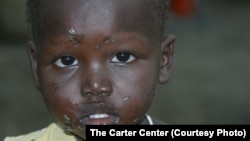The Carter Center’s Trachoma Control Program is working to eradicate the eye disease called Trachoma that often causes blindness. If left untreated, the disease causes the eyelids and lashes to grow inward, scratching the cornea.
Trachoma is found in over 50 countries in the world including the Americas and Asia, but is most commonly found in Africa and the Middle East.
The Carter Center – which is based in Atlanta, Georgia – works with other international organizations to implement the World Health Organization’s strategy to reduce and stop the spread of trachoma in the affected countries, especially in Ethiopia where the disease is most endemic.
The strategy is called SAFE, an acronym for surgery, antibiotics, facial cleanliness and environmental change. Surgery would be the last stage in treating Trachoma but personal hygiene – and especially keeping the face clean - is by far the most effective way prevent the disease.
It’s mostly women and girls who suffer from the disease, says Kelly Callahan, the director of the Carter Center’s Trachoma Control Program.
“Women are the caretakers of the children,” she said. “So it’s just natural that children are in closer proximity to their mothers during their formative years, especially between the ages of six months and five, before they start going to school.” Because they are grouped tightly together in childcare, women and children repeatedly transmit episodes of infection to one another, she says.
Callahan says young girls are impacted just as significantly as women because girls do not always have the opportunity to go to school. Instead, they stay home to help care for other family members.
“Flies are the biggest form of transmission,” she said.
“This disease requires repeated episodes over time and the way that happens is through a fly,” Callahan explained. Flies breed on human feces in the open air. “So, if there are plenty of latrines, the fly will have no place to breed.”
Flies also like to land on the human faces and feed off of the discharges from the eyes and nose. “And that’s actually how this disease is transmitted,” she said.
The four-pillar SAFE strategy promotes lessons such as the importance of face cleaning and maintaining clean latrines in their compounds that women and girls can embrace and teach other family members.
